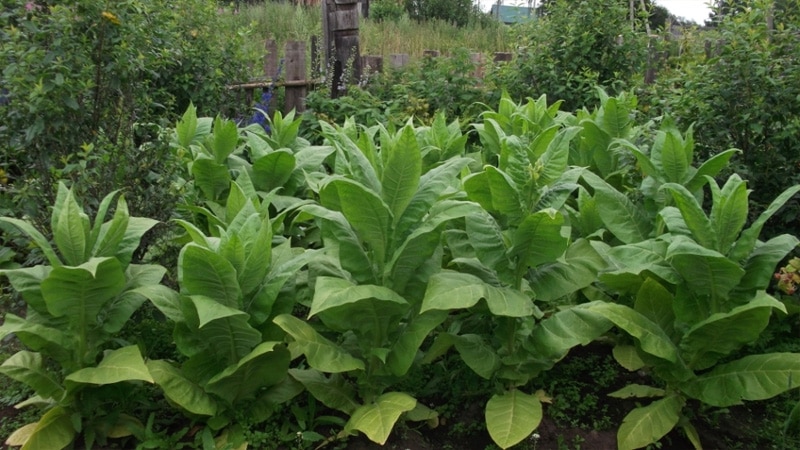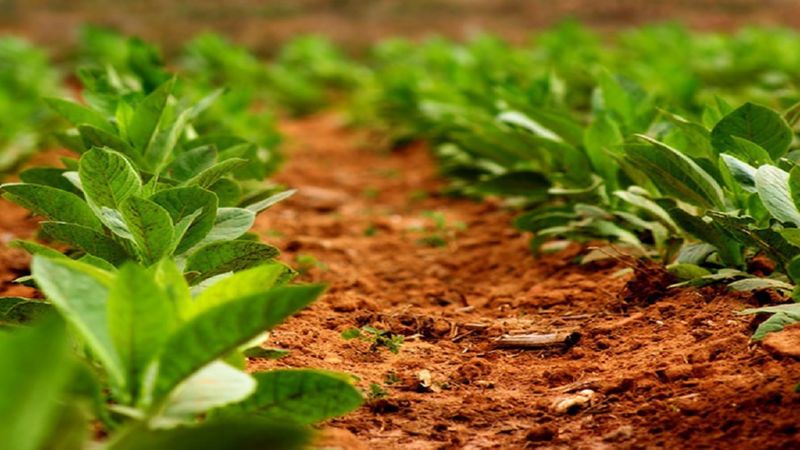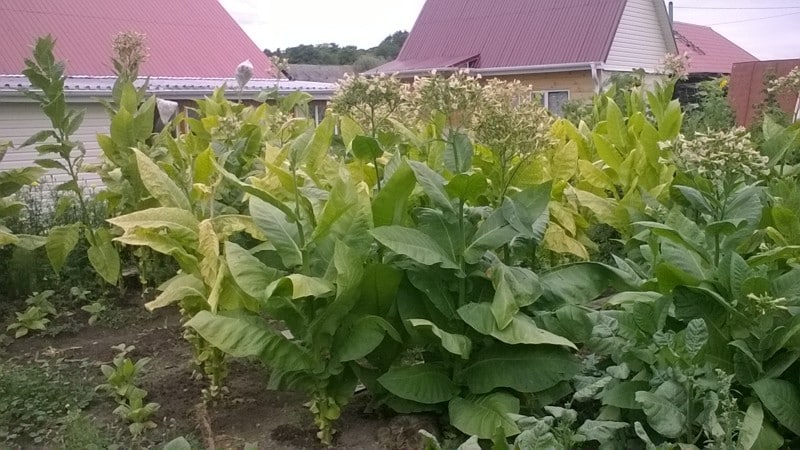Technology for growing tobacco in open ground, greenhouses and at home
Tobacco is a warm and moisture-loving plant. The preferred regions for its cultivation are southern, with a hot climate. In the middle zone, this plant is cultivated in greenhouses. Growing tobacco from seeds is no more difficult than growing tomatoes. We will tell you in this article how to plant tobacco, fight pests and diseases, and process leaves for storage and use.
Is it worth growing smoking tobacco?

Many gardeners ask this question. On the one hand, tobacco grown by yourself is obviously of better quality than purchased in a store. On the other hand, the standard 6 acres may not be enough to provide a plant with an annual supply - other crops also need space.
If you want to just experiment, just select a bed in a greenhouse or in the open air. Growing on a large scale will require a significant area.
Important! Before sowing tobacco, you should familiarize yourself with its varieties and their characteristics. In our country, two types of cigarette tobacco are grown. In both Americas - cigar.
Advantages and disadvantages of self-gardening
A significant advantage of growing tobacco yourself is its purity. In addition to the main ingredient, purchased cigarettes contain tar, various impurities, aromatic additives, causing additional harm to the health of the smoker.
Another advantage is savings. The average cost of a pack of cigarettes is 100 rubles.The family budget savings will be at least 30 thousand rubles. per year when switching to samosad.
Parts of tobacco that are not used for smoking purposes are excellent at controlling pests of garden plants. The disadvantages of growing are that it is almost impossible to predict varietal characteristics.
The final result will depend on many factors:
- soil composition;
- weather conditions;
- application of fertilizers;
- plant care.
When choosing a tobacco variety for self-growing, one takes into account not only its yield, but also its adaptability to different climatic conditions.
How to grow tobacco

In most regions of the Russian Federation, self-gardening is cultivated using seedlings. Since the growing season of the plant is long, sowing is carried out already in February - early March. This crop loves long daylight hours, and therefore it is transplanted into the ground no earlier than the end of May - beginning of June.
Tobacco grows well in almost any soil, but the quality of the finished product depends on the nitrogen, phosphorus and potassium content in the soil.
Important! You cannot grow a plant in the same place. It is planted on the old plot no earlier than after 4 years. After tobacco, the soil needs abundant fertilizing. Self-gardening greatly depletes the soil, drawing out a significant amount of minerals during the period of intensive growth.
Preparing and germinating seeds
2-3 days before sowing, the planting material is pickled with a weak solution of potassium permanganate, washed and dried. Because the tobacco seed very small, the best way for germination is to place them on the surface of several layers of damp toilet paper.
When the seeds hatch and produce roots, the seedlings are carefully transferred to peat pots or seedling boxes using tweezers.
Important! When sowing directly for seedlings in containers or pots, the seeds are evenly laid out on a damp surface, lightly sprinkled with earth and pressed down with glass. When green shoots appear, the glass is removed, and the seedlings are illuminated with a phytolamp.
Soil preparation
Tobacco loves loose soil, so for germination, purchase ready-made soil for garden plants or flowers. Such soil mixtures contain peat, which makes the soil loose.
Prepare the soil for seedlings yourself in the following proportions:
- sand – 1 part;
- humus - 2 parts;
- garden soil - 2 parts.
The soil in the garden or greenhouse is prepared in the fall. To do this, remove all remaining organic matter, dig the beds deeply and apply mineral fertilizers with a high content of nitrogen and potassium.
In the spring, after warming up, the soil is dug up and harrowed again. Before planting, seedlings are moistened abundantly and fertilized again.
Important! The soil from the site is replete with microorganisms, fungi, pests and weed seeds. Before planting tobacco, it is treated with a strong solution of potassium permanganate, and as foreign plants appear, they are promptly weeded out.
Planting seedlings

Prepared and germinated seeds are planted in individual containers - disposable plastic cups or peat pots. Seeds sown immediately in seedling boxes dive when 3-4 leaves appear.
Drainage holes are made in containers for seedlings to prevent stagnation of water and acidification of the soil. Otherwise, the plants will die.
The seedlings are planted in moist soil and placed in a place well lit by the sun.A glazed and insulated loggia is ideal. Lighting is necessary until the seedlings are planted in the ground or greenhouse.
Watering is carried out after 1-2 days as the soil dries. 2 weeks before planting in the ground, the seedlings are hardened off. To do this, reduce the frequency of watering and transfer the containers with seedlings to the greenhouse, which is ventilated both day and night. If there is no greenhouse, the seedlings are left outside, but brought into a cool room at night.
After hardening is completed, the seedlings are placed in prepared beds, pre-moistened. In greenhouses it is best to make high beds, and in open ground tobacco is planted in ridges. This will protect against return frosts and facilitate hilling during the growing season.
Care
Plants planted in the ground or greenhouse are watered in a timely manner, fed 3-4 times during the growing season, pinched and the tops cut off during budding.
For watering, it is best to use drip irrigation. It delivers moisture directly to the roots and prevents weeds from developing.
Fertilizers are applied for the first time 10-12 days after planting the seedlings in the soil. Immediately after it, hilling is carried out. The second mineralization is carried out a month later. The third fertilizing is applied at the beginning of flowering. Since potassium, phosphorus and nitrogen are vital for tobacco, fertilizers are selected taking into account the high content of these elements.
The greatest productivity of fertilizers for tobacco is associated with their application directly into the top layer of soil - the development of the root system provides nutrition to the plant.
After applying each top dressing, the tobacco is hilled up and the 2-3 bottom leaves are cut off. This will allow the formation of powerful stems on which marketable leaves will develop.
Each tobacco leaf has a stepson.They need to be pinched when they reach a size of 2-2.5 cm. If you do this earlier, the stepson will grow back. If it is later, the beneficial leaves will not receive enough nutrition.
When the budding process begins, the tops of the tobacco are cut off. This stimulates the growth of powerful green mass. Otherwise, most of the nutrition will go to fruit formation.
Important! To obtain seed material, it is enough to leave 2-3 of the most developed and beautiful plants and not cut off the buds from them.

Possible diseases and pests
Tobacco is often susceptible to diseases, some of which are viral, which are useless to fight. These include tobacco and cucumber mosaics, white mottled and bronze. If signs of viral infections are detected, diseased plants are weeded out and burned.
To combat fungi (root and seedling rot, powdery mildew, downy mildew, dry white spot), 50% Benlata powder and polycarbacin are used.
The most dangerous pests of tobacco:
- Wireworm. It damages the roots, penetrates through them into the stems and eats them away from the inside. It is almost impossible to cope with it, so prevention is important. To do this, 2 weeks before planting the seedlings, the soil is treated with a 12% hexachlorane solution and harrowed to a depth of 3-4 cm.
- Tobacco thrips. It bites through the leaves and sucks the juice out of them. Affected plants are stored worse, ferment more difficult and lose their taste. Treatment with insecticides saves you from this pest.
- Peach aphid. It is dangerous not only because it affects the leaves. It carries incurable diseases, depletes plants and reduces yields. To combat insects, they are treated with metathion or “Rogor”.
To prevent the spread of diseases or the proliferation of pests, plants are regularly inspected for lesions. If diseases or insects are detected, measures are immediately taken to destroy pests and treat diseases.
Harvesting
As soon as the tobacco leaves stop growing, they begin to be harvested. To do this, cut off the lowest leaves, then move on to the middle ones. Lastly, cut off the top ones. Cleaning is carried out in the evenings, in dry weather.
How to grow tobacco at home

The self-garden does not feel very good on a windowsill or balcony. It needs a large feeding area, constant ventilation, plenty of moisture and regular feeding. There is not enough space to obtain full-fledged plants at home.
But you can grow tobacco at home. Germinate the seeds and prepare the soil in the same way as for seedlings. Containers after diving must be at least 30 cm in diameter and 50 cm in depth. Place pots of tobacco in such a way that the plants are evenly illuminated and ventilated.
Since tobacco is a long-day crop, phytolamps will be required for additional illumination for at least 10-12 hours a day.
What to do next
The collected leaves are dried in a dark, ventilated room at a temperature not exceeding +25...30°C. As the leaves dry, they naturally ferment.
Fermentation carried out during storage. Some varieties of tobacco reach their final varietal qualities within several years when stored in oak barrels or special bags.
At home, dry leaves without green spots are selected for fermentation. In the presence of chlorophyll, the fermentation process is impossible.The leaves are generously moistened with water from a spray bottle, folded into a tight pile and wrapped in plastic wrap.
After a day, the midrib is removed from each leaf. The finished leaves are dry, elastic and do not break at the bends. They are cut into strips and placed in glass jars, filling them no more than 2/3. Cover with metal lids and place in an oven preheated to +50°C.
The tobacco is fermented for a week, and the cans are periodically removed and shaken so that the process proceeds evenly.
Storing finished tobacco
After fermentation, the crushed leaves are dried again in a dark, ventilated area and transferred to a container for a long time. storage.
Do not store fermented tobacco in plastic or metal containers. It is best to use thick paper or linen bags, glass jars with a rub-on lid.
Conclusion
Smoking is definitely a bad habit. But you can reduce the harm caused by nicotine by growing and consuming good quality tobacco without additional impurities. Difficulties in cultivation are caused only by a large number of pests and diseases, which must be combated even before planting seedlings in the ground.
The right variety tobacco for smoking and compliance with growing technology guarantees a high-quality and abundant harvest.